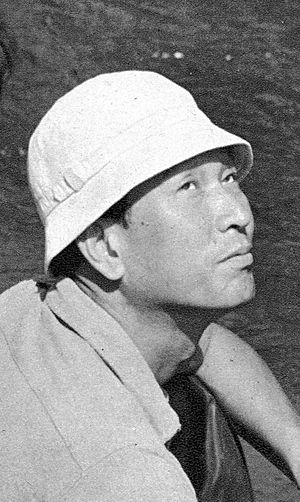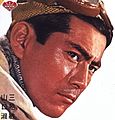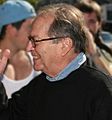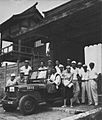Akira Kurosawa facts for kids
Quick facts for kids
Akira Kurosawa
Junior Third Rank
|
|
|---|---|
| 黒澤 明 | |

Kurosawa on the set of Seven Samurai in December 1953
|
|
| Born | March 23, 1910 |
| Died | September 6, 1998 (aged 88) Setagaya, Tokyo, Japan
|
| Resting place | An'yō-in, Kamakura, Kanagawa, Japan |
| Occupation |
|
| Years active | 1936–1993 |
|
Notable work
|
|
| Height | 182 cm (6 ft 0 in) |
| Spouse(s) |
Yōko Yaguchi
(m. 1945; |
| Children | Hisao (b. 1945–) and Kazuko (b. 1954–) |
| Awards |
|
| Japanese name | |
| Kanji | 黒澤 明 |
| Romanization | Kurosawa Akira |
| Signature | |
 |
|
Akira Kurosawa (born March 23, 1910 – died September 6, 1998) was a famous Japanese film director and writer. He made 30 movies over 57 years. Many people think he was one of the most important filmmakers ever.
Contents
His Life and Movies
Kurosawa was born in Tokyo, Japan, on March 23, 1910. His father, Isamu, was from a samurai family. He worked as a director at a sports school. His mother, Shima, came from a merchant family. Akira was the youngest of eight children.
His father liked Western ideas and thought movies could teach people. He encouraged his children to watch films. Young Akira saw his first movies when he was six. A teacher named Mr. Tachikawa also helped him. This teacher made Akira love drawing and learning. Akira also studied calligraphy (fancy writing) and Kendo (Japanese sword fighting).
Kurosawa started working in the Japanese film industry in 1936. Before that, he was a painter. He spent years as an assistant director and writer. His first movie as a director was Sanshiro Sugata (also called Judo Saga). This was during World War II.
After the war, Kurosawa made Drunken Angel (1948). This movie was very popular with critics. In it, he cast an unknown actor named Toshirō Mifune. Mifune became a big star. Kurosawa and Mifune worked together on 15 more films.
International Success
In 1951, Kurosawa's movie Rashomon won the Golden Lion award at the Venice Film Festival. This was a big surprise! Because of this movie's success, Japanese films became popular in Western countries for the first time. This helped other Japanese filmmakers become famous around the world.
Kurosawa made about one movie each year in the 1950s and early 1960s. Some of his most famous films from this time include Ikiru (1952), Seven Samurai (1954), and Yojimbo (1961). Many of these movies have been remade by other directors.
Later Films and Influence
In 1977, American director George Lucas made Star Wars. This very popular science fiction movie was inspired by Kurosawa's The Hidden Fortress. Lucas and many other directors looked up to Kurosawa. Lucas was sad to hear that Kurosawa was having trouble finding money for new movies.
In 1978, Lucas met Kurosawa. They talked about Kurosawa's idea for a movie called Kagemusha. It was an epic story about a thief who pretends to be a medieval Japanese lord. Lucas loved the story and Kurosawa's drawings. He used his influence to help Kurosawa get the movie made. Another famous director, Francis Ford Coppola, also helped produce it.
Kagemusha was a huge hit in Japan. It also did very well in other countries. It won the important Palme d'Or award at the 1980 Cannes Film Festival.
Because Kagemusha was so successful, Kurosawa was able to make his next big movie, Ran. This was another epic film.
Ran won several awards in Japan. Kurosawa was nominated for Best Director at the 58th Academy Awards. However, the award went to Sydney Pollack for Out of Africa. The costume designer for Ran, Emi Wada, won the movie's only Oscar.
Many people think Kagemusha and Ran are among Kurosawa's best movies. After Ran came out, Kurosawa said it was his best film. Before that, he always said his "next one" would be his best.
In 1990, Kurosawa received an Academy Award for Lifetime Achievement. This award honored his amazing career.
Akira Kurosawa passed away on September 6, 1998, from a stroke. He was 88 years old. His work is still studied and celebrated around the world.
His Impact and Legacy
Kurosawa is often called one of the greatest filmmakers ever. In 1999, AsianWeek magazine and CNN named him "Asian of the Century" in arts and culture. They said he was one of the five people who helped Asia the most in the last 100 years.
In 2002, a poll of directors and critics ranked him as one of the top five greatest directors of all time. In 2010, for the 100th anniversary of his birth, a project called AK100 was started. Its goal is to share Kurosawa's spirit and movies with young people everywhere.
Awards and Honors
Two film awards are named after Kurosawa. The Akira Kurosawa Award for Lifetime Achievement in Film Directing is given at the San Francisco International Film Festival. The Akira Kurosawa Award is given at the Tokyo International Film Festival.
Kurosawa also received many honors from different countries. He was made an officer of the French Légion d'honneur in 1984. He also received a high honor from Italy in 1986. In 1985, he was the first filmmaker to receive the Order of Culture from Japan. After he died, he was given the Junior Third Court Rank, a very high honor in Japan.
Images for kids
-
Kurosawa (left) and Mikio Naruse (right) during the production of Avalanche (1937)
-
Toshiro Mifune, a frequent lead in Kurosawa's films, on the poster of 1950's Scandal
-
Sidney Lumet successfully requested that Kurosawa be nominated as Best Director for his film Ran at the 58th Academy Awards. The award was ultimately won by Sydney Pollack.
-
Steven Spielberg helped finance the production of several of Kurosawa's final films. Spielberg at his masterclass at the Cinémathèque Française in 2012.
-
Ingmar Bergman, shown here in a bust located in Kielce, Poland, was an admirer of Kurosawa's work.
-
Jacques Rivette, a prominent critic of the French New Wave who assessed Mizoguchi's work to be more wholly Japanese in comparison to Kurosawa's.
See also
 In Spanish: Akira Kurosawa para niños
In Spanish: Akira Kurosawa para niños











